From Hadrian’s Gate to the Port of Antalya, this tour will walk near the former Greek Churches of Kaleiçi. This walking tour replicates the area that the Apostle Paul likely walked from Perge into the city’s port.
Crosses at Hadrian’s Gate
Hadrian’s Gate, built in 130 AD, marks the route from the port toward the ancient city of Perge. When Paul headed to Perge (Acts 13:13 and 14:25), he landed at a nearby port (Magydus)[1]see https://dergipark.org.tr/tr/download/article-file/1122747 but later left from Antalya port. His walk from Perge northeast of the boat landing would have most likely taken him through this pathway, which is now Hadrian’s Gate.
Hadrian ruled Rome from 117 to 138 AD and built walls and fortresses from Britain to Syria, and this gate gives evidence of how he wanted to strengthen this important port city.[2]https://www.britannica.com/biography/Hadrian/Artistic-achievements As a ruler, he was known for crushing those who opposed him, but he did not have a specific policy to persecute Christians. He followed Trajan’s pattern and dealt with unlawful behavior ruthlessly.[3]https://www.historytoday.com/archive/causes-early-persecutions
Notice the steps down and up near the gate; this shows that the current old walled city sits upon the ancient ruins about six feet under the narrow passageways of the town. Mark W. Wilson, a scholar in the region, said, This historic walled “Old City” is situated over the remains of Greco Roman Attalia founded around 167 BCE by Attalus II.[4]The Discovery of a Menorah in Attalia (Kaleiçi, Antalya) and its Significance for Jewish Communities in Pamphylia, Mark Wilson, ADALYA 23, 2020, 348. In the multiple empty lots and below the surface digs, one can see the many remains that sit about 4 to 8 feet below the surface.
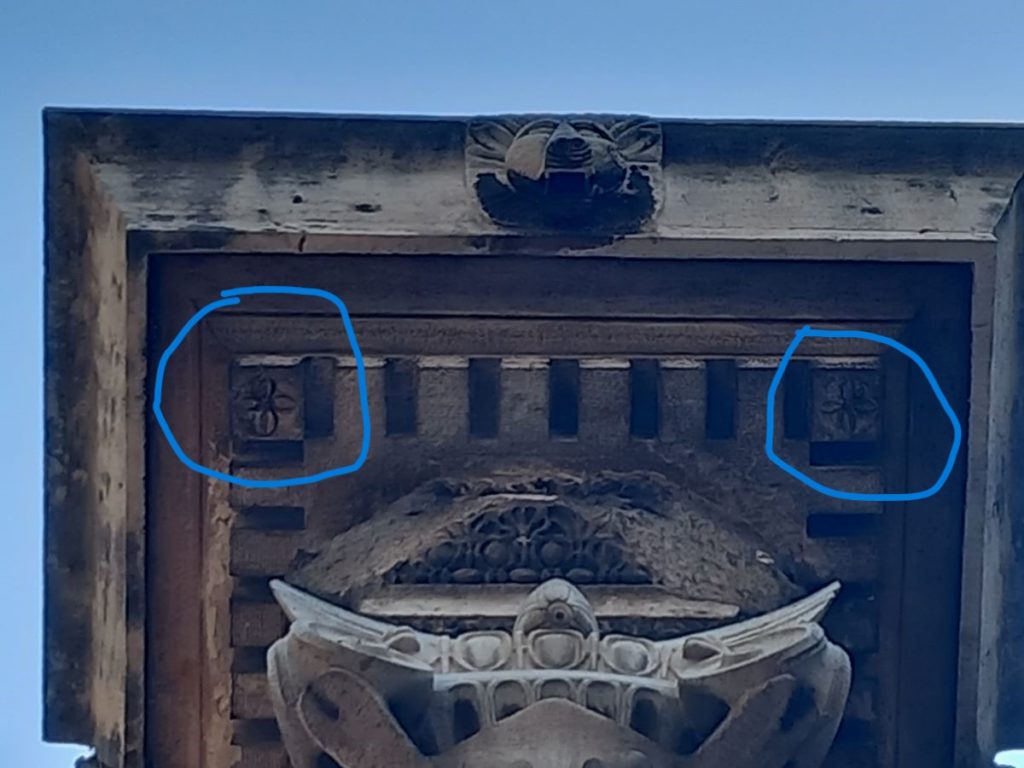
On the upper ledge (inside of the gate), the later Byzantine design gives way to small hidden crosses on the corners. Not all the ledges have similar patterns, but one shows two crosses, while on another, the upper column displays a cross (pic below).
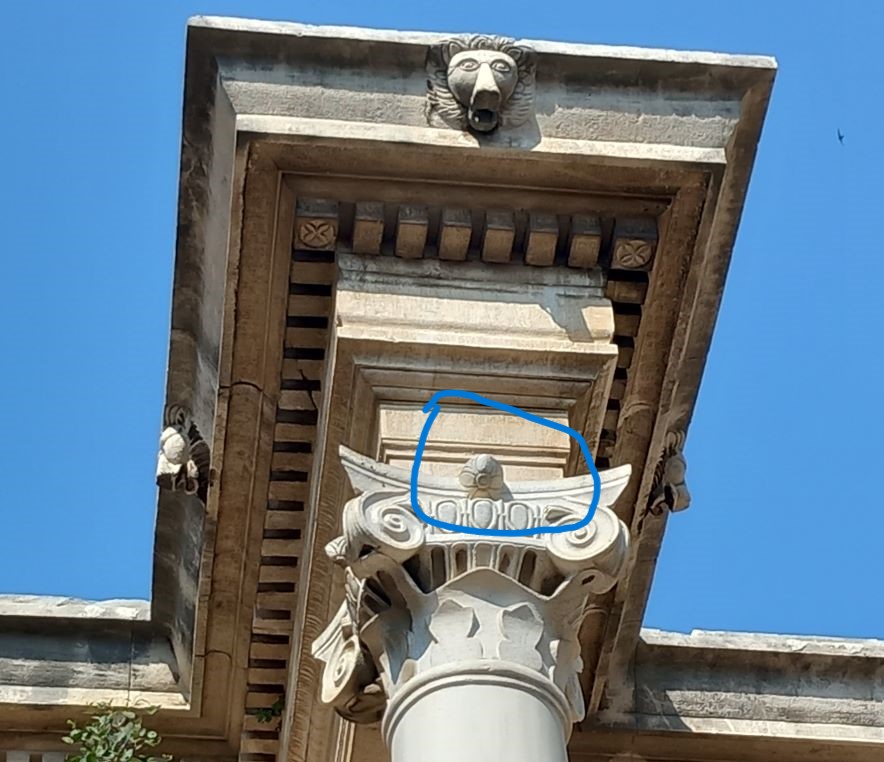
Street Sign Crosses
As one enters Kaleiçi, on the left before the first street, the wall on the left depicts a cross about six feet above the ground (Across from Schiller’s Bistro). The cross on the left side wall marks the area set aside for the Greek population. The Ottomans made these neighborhoods a place for Greeks to settle while the Turks settled north and west of the port. This Greek quarter is where we will see the former churches and the place that Greeks most likely lived before the Seljuks arrived.
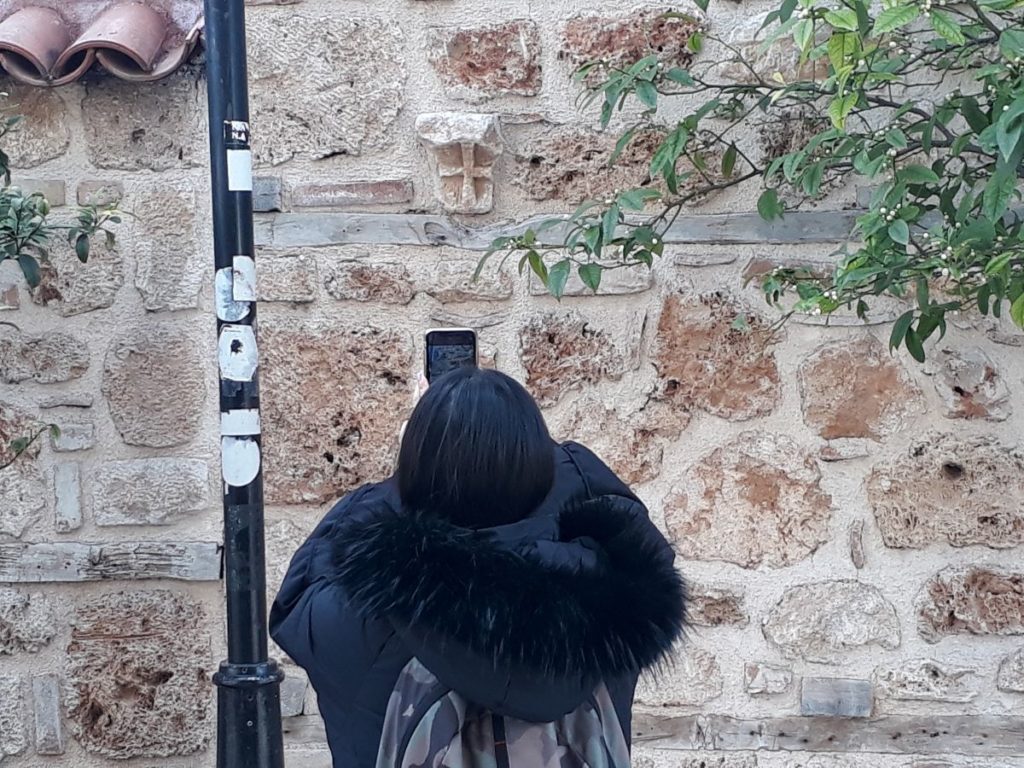
For Google Maps: place in the following location from Hadrian’s Gate (A): B. Suna – İnan Kıraç Müzesi, C. Site where a Jewish Menorah was found. D. Panagia Greek Orthodox Church (now a Mosque), E. Sehzade Korkut Mosque, F. Park looking out over the Harbor, and then G. Iskele Mosque. A 1.1 km walk is displayed on the Google Maps app and will take one over an hour and longer, depending on how one visits the sites. (If you start at the Port area, reverse the order.) Here is the link to my Google walking map.
From Hadrian’s Gate, we head straight with a very slight left from the Gate to our next stop
Suna – İnan Kıraç Müzesi (B)
St. George Greek Orthodox Church – this former church now houses Suna – İnan Kıraç Müzesi, which displays the church and a 19th-century Turkish house. At least five known Greek churches existed in the old city, with a few others suspected. This one, most likely the newest built of the known churches, was named after George, a martyred Greek soldier. At his death, he refused to recant his faith during the Diocletian persecution of Christians (he died in 303 AD). Greek-speaking churches honor him in Turkiye since he came from the Cappadocian area. Interestingly, the Greek writing above the door displays Turkish sentences that say this church was built in 1863, along with a comment that the site housed a church long before this.
The former church, now a museum, houses some religious relics and other historical exhibitions. Notice the two existing doors, which both show religious symbols above the doors. St. George, known for killing a dragon that threatened the people, can be seen on the west doorway along with Seraphic angels.
Departing left from the Museum, we return to the street we came on previously.
Signage on the Streets
After a few blocks, this corner where Gazetta Restaurant sits hosts a corner design highlighting a cross. The eight-pedal design, also found in the Hagia Sophia, represents an outward symbol for those who used to live in this area.

Heading on to Müze Street, there lies an empty lot on the left associated with 14 Müze (C on Google Map). Pieces of a Jewish Menorah were found at this site. Thus, suspecting that a synagogue existed near this area.[5]Mark Wilson writes about this https://www.academia.edu/44653714 At the end of this street lays a small square, which a former Greek Church called St. Nicholas used to reside on this square. Now Candle Suites resides where this church most likely was. As we take a right, we approach the Alaeddin Camii, and on the first doorway (#30) at this turn displays an unknown symbol that looks very Jewish.
Panaya Church – Alaaddin Mosque (D)
Panaya Church (or Panagia – meaning virgin), now the Alaaddin Mosque (D), was the most important Greek church during the 19th century. The building constructed in 1834 was built upon the foundation of a Byzantine church.[6]Antalya Cultural Inventory, Antalya Valiliği 2004, 38. The Byzantine churches spoke Greek and became a part of the Greek Orthodox Church in 1054 A.D. with the Great Schism. So, when we see Greek church buildings in Turkiye from the 18th and 19th centuries, we can assume in many places, there existed a Byzantine church at that location before or nearby. Some scholars say a church was at this site in the 15th century.[7]https://akmed.ku.edu.tr/en/inventory/alaaddin-mosque/
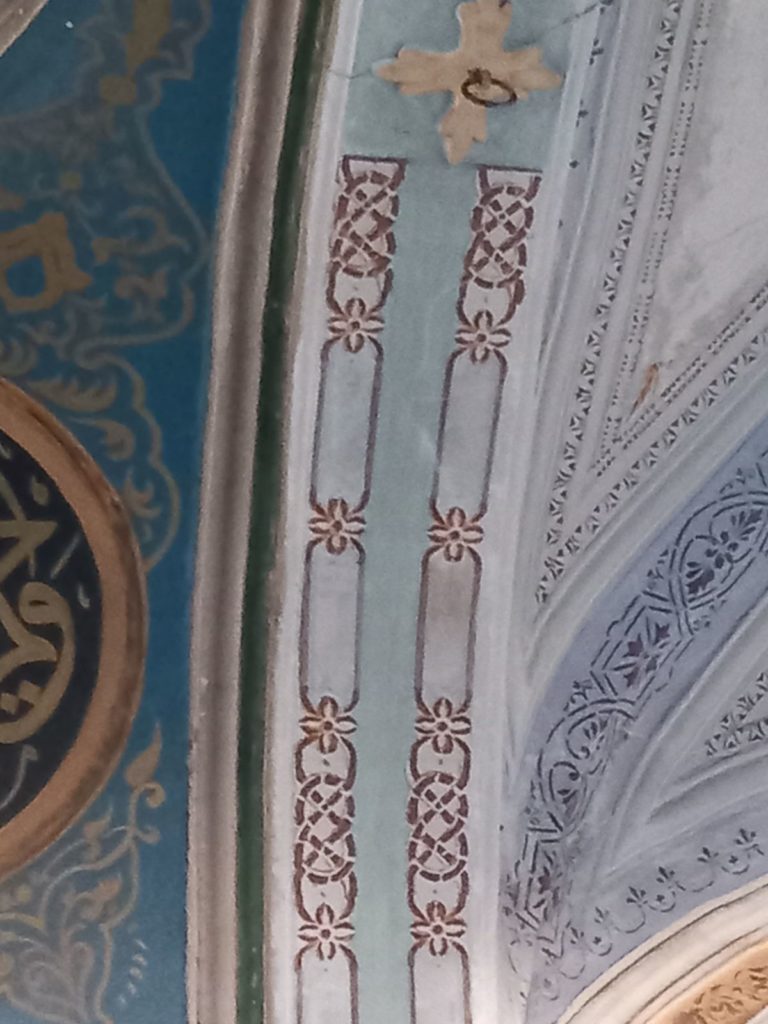
Much like the church at St. George, many Greek and Armenian churches throughout the major cities of Turkiye were constructed in the 19th century. It was a period demonstrating some freedom and economic wealth for the Greek Christians in the city. This was most likely a result of the Tanzimat Edict of 1839 to 1876, which gave Christians more freedom to build new buildings within the Ottoman empire.[8]https://rpl.hds.harvard.edu/faq/tanzimat-reforms The blue in this building displays a common color pattern used by the Greeks in the 19th century, evidenced in the Grecian flag.
The mosque retains most of the Christian patterns. Large cross-presentation exists mainly in the ceiling designs of this 19th-century building, along with the “X” symbol representing Christ in Greek. There is an amazing similarity between these interior designs and the Greek Church (Hagia Triada) at Taksim Square in Istanbul. In many small designs, small crosses or flower cross-like patterns demonstrate the Greek influence on 19th-century patterns. In the picture on the right, angels are inter-dispersed among the crosses.
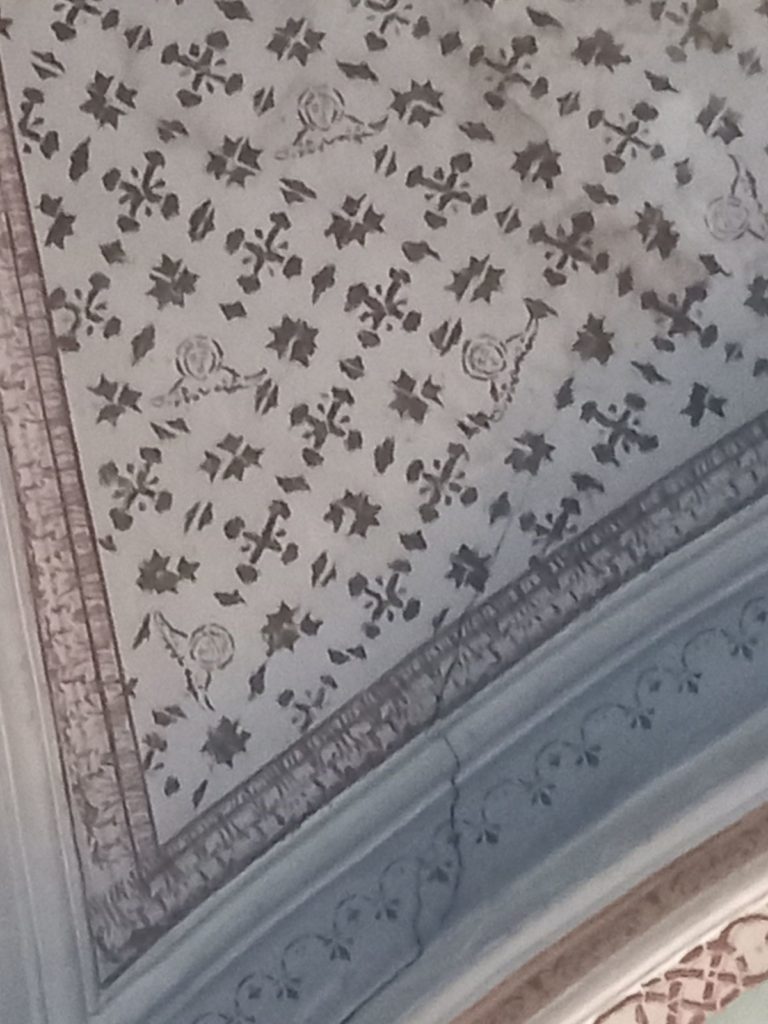
Courtyard Furniture
The partial tower near the entrance hosted a bell that rang out the time of worship. Also, the locked backyard hosts a Kaleiçi well found in many courtyards along what appears to be the former marble communion table.
The name Panagia (Virgin Mary) repeats on our next visit – a church around the corner with the same historical name. The Kesik Minera mosque took over the former church in 1469, forcing the congregation to move possibly to this location. So, most likely, we just visited the second Panagia church in the old town. Our tour will approach the next site from its back courtyard.
Virgin Mary Church – Kesik Minera Mosque (E)
Virgin Mary Byzantine Church (Παναγία – Panagia) – Kesik Minera Mosque – now known as Şehzad Korkut Camii. The multiple names for these sites reflect the historical turmoil of the location. The first church was built upon the ruins of a Roman temple in the 5th-6th century.[9]It’s a Mosque now; Panhagia, Kesik Minare from Antalya, Gamze Kaymak-Heinz, 2020, 325. So the location reflects a temple built in the 2nd till 5th century, a church from 5th to 13th century, then a mosque from the 13th century to 1361, again a church from 1361 to near to 1469, again a mosque 1469 to 1896 (fire), and then a restored mosque in 2020.[10]https://turkisharchaeonews.net/object/broken-minaret-antalya So the place hosted a temple once, at least twice a church, and three times a Mosque. For these reasons, the multiple names for the site. Please check out my write up on this former Byzantine church.
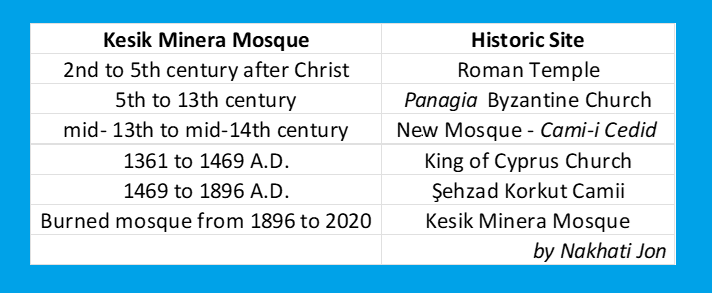
History Influences
The Turkish historian, Evren Dayar states two very interesting things about this place. One that the location most likely was shared as a church and mosque during the late 17th, early 18th century. The change of population increased where the neighborhood again became dominate by Greeks. Soon after becoming a mosque again, the fire of 1896 burned down the neighborhood from here to the Hidirlik Tower.[11]Antalya Kaleiçi Panhagia Kilisesi ve Câmi-i Cedid, Evren Dayar, 535. “Panaghia Kilisesi câmiye dönüştürüldükten sonra yaklaşık dört asır boyunca Müslümanların ibadetine açık … Continue reading

In this former church, the inside structure shows the Roman, Christian, and Islamic influence on the building. The cross hides as part of some upper capitals, along with fish and heart symbols, to show the Christian faith. Below, the glass on the left displays a few broken crosses, along with some in the back courtyard.
So far, we have walked through the Greek-assigned neighborhood that the Ottomans set up to separate the Christians and Muslims. The other Muslim section, not on this walking tour, includes the Clock Tower and the Yivliminare Mosque area. No churches remain in the upper castle area or the western section of the city.[12]See Antalya Kaleiçi Panhagia Kilisesi ve Câmi-i Cedid, Evren Dayar, 546-547. However, the port side of the harbor was a shared space. One Christian site existed near the port; let’s go and see what remains.
Kecili Park (F)
On the way down, we will stop at Kecili Park, a great place for a picture overlooking the harbor.
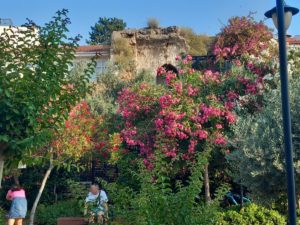
When entering the park, on the left side, there hides evidence of a former Greek building above the trees. The Greeks called it St. Dimitrios, but little is known about this former church or school. When I inquired on the other side at 28 Hidirlik Sokak, they knew nothing about any former church. On older maps, this is the Kaleici wall, but it looks like a building was a part of the wall at this location.
Iskele Camii – Ayazma (G)
Iskele Camii – Ayazma site – On maps, if one searches for churches in the old city of Antalya, one will see the name Ayazma (Αγιάζμα), which means consecration in Greek, often describes a sight with holy water.[13]Many churches with the same name in Istanbul https://www.hurriyetdailynews.com/holy-springs-healing-springs-istanbuls-ayazma-42148 The mosque built in 1905 stands uniquely in an elevated situation.[14]In the 1530 census, a neighborhood referred to a mosque here at the port. Even in the 18th century, the name was only “mosque,” with no formal name. – according to Evren DAYAR in … Continue reading
In Evren Dayar’s write-up about the history of the port and the late 19th century to the beginning of the 20th-century repairs, it appears that reconstruction of the port did not come quickly or efficiently. The result of an elevated mosque and the Greek baptism or spring most likely resulted in a compromise between Muslim and Christian/Greek merchants.
For these reasons, we stand before a semblance of a Greek baptism. Near the wall was possibly the location of the former religious area where currently some men sell caps to tourists who walk by.
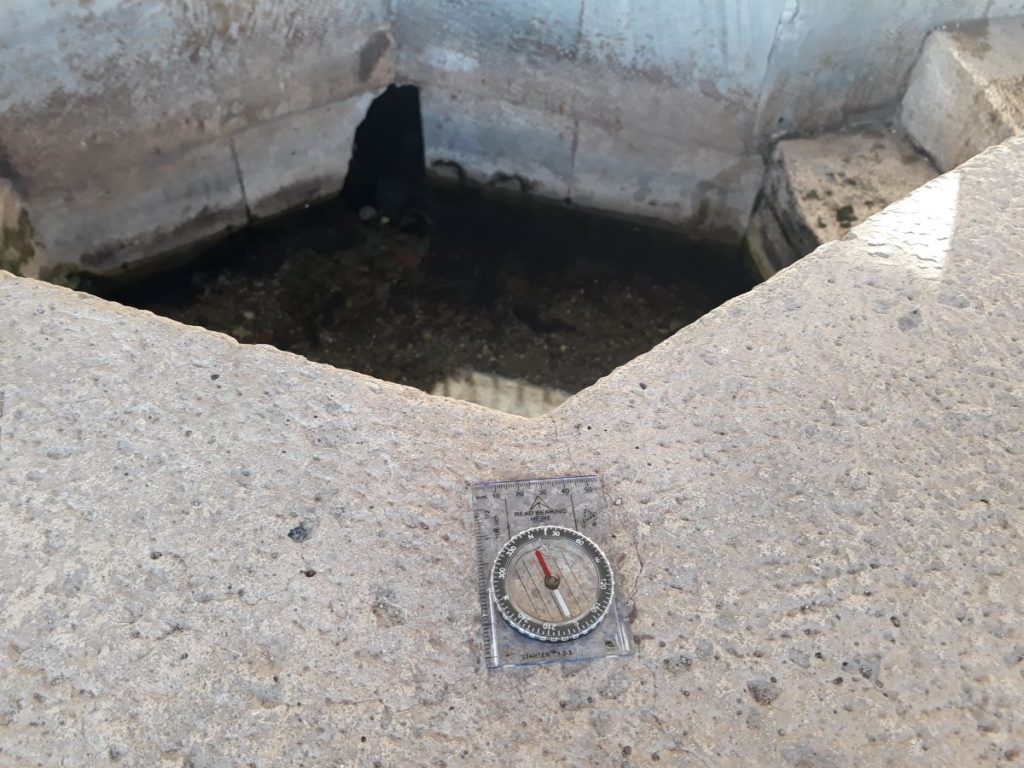
The Byzantines entered the Baptism pool from the West to say goodbye to their sins. Then, after immersion, walked out toward the East. The chamber sits in a West-East direction, giving evidence of its Christian past.
Many Greeks considered a baptism near the Port where Paul entered the region as a blessed place.[15]When swimming in the area, notice the many freshwater currents that chill; the seaside has many springs.
Some say this is only a spring, but the shape and direction of the steps tell a different story. As mentioned, the separation of Christians and Muslims in Kaleiçi reserved the port area as a shared space. A possible Greek building existed at least until the beginning of the 20th century. The pic below shows the building set into the hillside.
Earlier Pictures
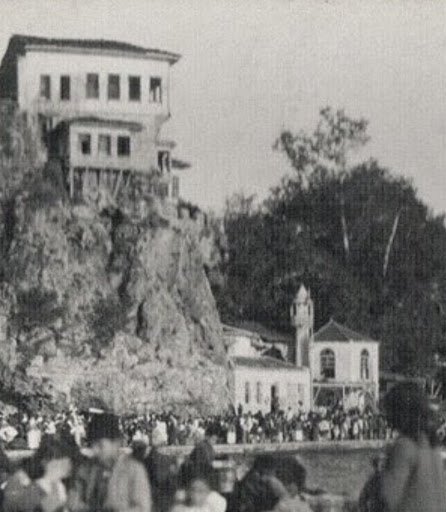

From 1910 to the 1930s, a few buildings existed between the Mosque and the hillside. Many seem to use the hillside as part of the structure.[16]Also see OSMANLI İMPARATORLUĞU’NUN SON DÖNEMLERİNDE ANTALYA KALEİÇİ VE ÇEVRESİ by Evren DAYAR, picture found from his write up. The brick building left of the mosque reflects a Greek structure while the other wooden building behind the mosque with Turkish design.
If you enjoyed this tour, please post. The book Searching Below the Surface gives a deeper discussion of the difference between Christianity and Islam.
Other church sites in the Old City of Antalya:
- Alp Orthodox church (Agios Alypios), which now hosts the Russian Orthodox Church near Yenikapi in Kaleiçi.
- Yivli Minaret Mosque – built upon the ruins of Aya İonnis Tu Teoloğu Church.[17]https://etd.lib.metu.edu.tr/upload/12620242/index.pdf A former six-domed Byzantine church. If one visits there, notice the 12 pillars from the former church. Other sites verify a church there. Check out my walking tour near the upper port area that explores this.
- Aziz Theodoros School – still researching the mentioning of this school.
- A former Armenian church near Hamam Cikmazi Sokak—now no evidence of existence, but it lay between the apartment complexes. Video of location.
- St Panteleimon Church[18]Çimrin, H. 2017. Antalya’da Tarihi Camiler, Medreseler, Türbeler, Yatırlar, Mezarlıklar, Eski ve Yeni
Kiliseler. Antalya: ATSO. My walking tour of this location.
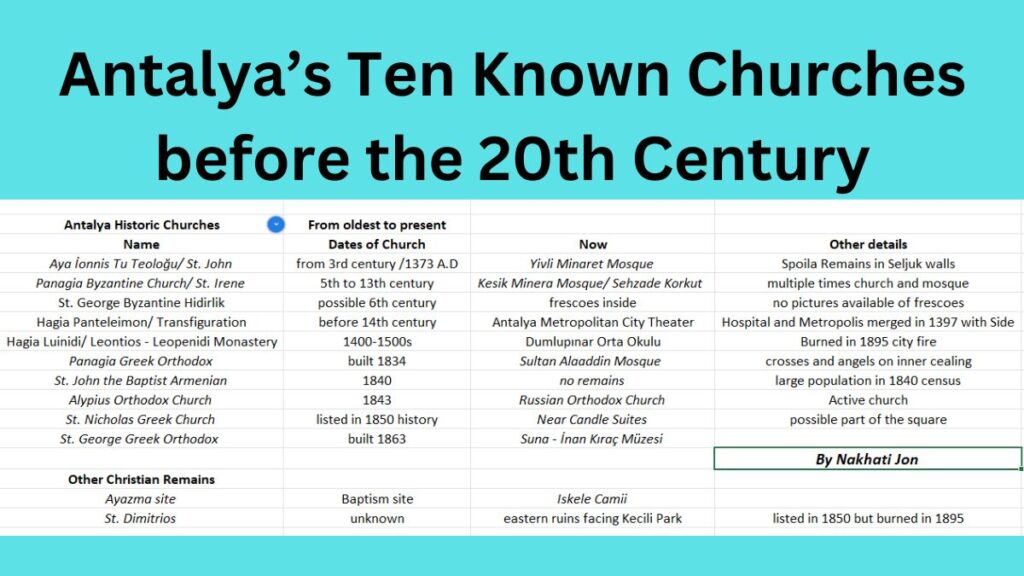
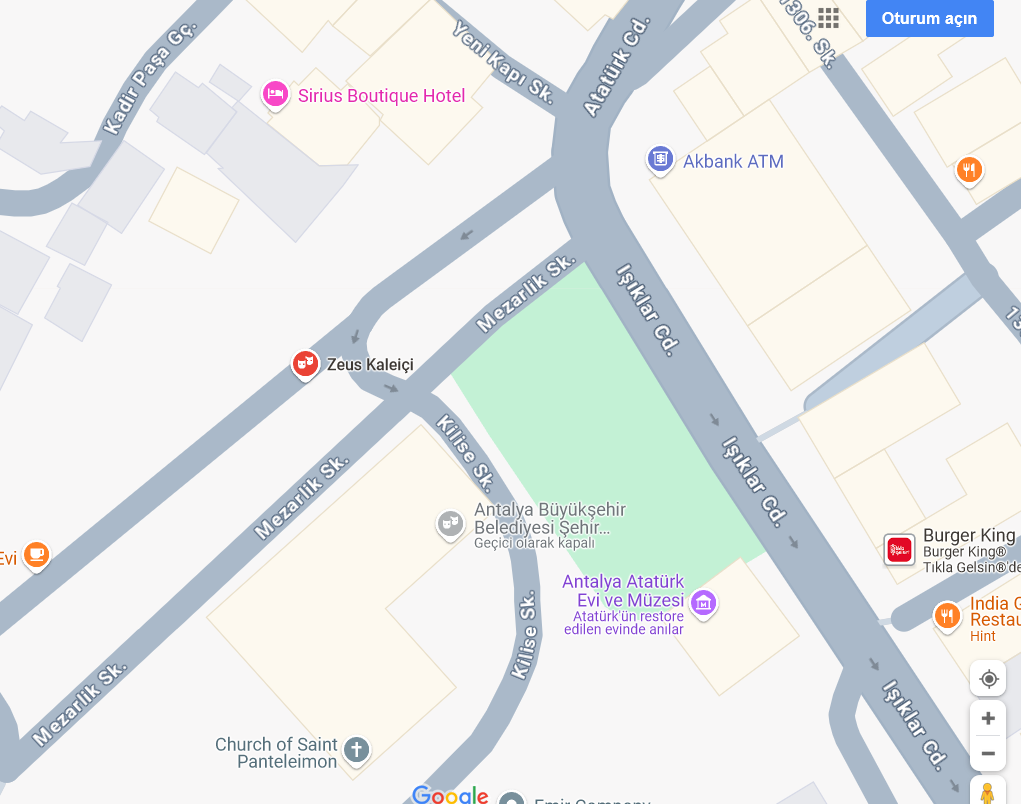
References
| ↑1 | see https://dergipark.org.tr/tr/download/article-file/1122747 |
|---|---|
| ↑2 | https://www.britannica.com/biography/Hadrian/Artistic-achievements |
| ↑3 | https://www.historytoday.com/archive/causes-early-persecutions |
| ↑4 | The Discovery of a Menorah in Attalia (Kaleiçi, Antalya) and its Significance for Jewish Communities in Pamphylia, Mark Wilson, ADALYA 23, 2020, 348. |
| ↑5 | Mark Wilson writes about this https://www.academia.edu/44653714 |
| ↑6 | Antalya Cultural Inventory, Antalya Valiliği 2004, 38. |
| ↑7 | https://akmed.ku.edu.tr/en/inventory/alaaddin-mosque/ |
| ↑8 | https://rpl.hds.harvard.edu/faq/tanzimat-reforms |
| ↑9 | It’s a Mosque now; Panhagia, Kesik Minare from Antalya, Gamze Kaymak-Heinz, 2020, 325. |
| ↑10 | https://turkisharchaeonews.net/object/broken-minaret-antalya |
| ↑11 | Antalya Kaleiçi Panhagia Kilisesi ve Câmi-i Cedid, Evren Dayar, 535. “Panaghia Kilisesi câmiye dönüştürüldükten sonra yaklaşık dört asır boyunca Müslümanların ibadetine açık kalmıştır. Fakat XVIII. yüzyılın ikinci yarısında başlayan, XIX. yüzyılda ise Kaleiçi’nin nüfus dengesini tersine çeviren bir başka dönüşümden etkilenmiştir. Bu dönüşümün ilk aşamasında kentteki Rum nüfusun sayısı artmış ve gayrimüslimler tekrar Kaleiçi’nin hâkim topluluğu olmuş; ikinci aşamasında ise Câmi-i Cedid cemaatsiz kalmış ve bir dizi talihsiz olayın da etkisiyle bütünüyle terk edilmiştir.” |
| ↑12 | See Antalya Kaleiçi Panhagia Kilisesi ve Câmi-i Cedid, Evren Dayar, 546-547. |
| ↑13 | Many churches with the same name in Istanbul https://www.hurriyetdailynews.com/holy-springs-healing-springs-istanbuls-ayazma-42148 |
| ↑14 | In the 1530 census, a neighborhood referred to a mosque here at the port. Even in the 18th century, the name was only “mosque,” with no formal name. – according to Evren DAYAR in YÜZYILDA ANTALYA’NIN MAHFUZ LİMAN SORUNU VE İSKELE TAMİRATLARI. He also said that Christians resided at the port during the 13th and 14th centuries. |
| ↑15 | When swimming in the area, notice the many freshwater currents that chill; the seaside has many springs. |
| ↑16 | Also see OSMANLI İMPARATORLUĞU’NUN SON DÖNEMLERİNDE ANTALYA KALEİÇİ VE ÇEVRESİ by Evren DAYAR, picture found from his write up. |
| ↑17 | https://etd.lib.metu.edu.tr/upload/12620242/index.pdf |
| ↑18 | Çimrin, H. 2017. Antalya’da Tarihi Camiler, Medreseler, Türbeler, Yatırlar, Mezarlıklar, Eski ve Yeni Kiliseler. Antalya: ATSO. |
[…] Finding Hidden Churches – Walking Tour of Kaleiçi, Antalya […]